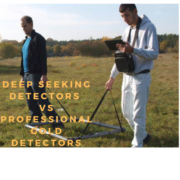Guide:Difference Between Deep Seeking Detectors vs Professional Gold Detectors
Difference Between Deep Seeking Detectors vs Professional Gold Detectors
-
Price
The deep seeking detectors start from 350,000 Pakistani rupees and have the highest range of 700,000 Pakistani rupees whereas the high end, most expensive gold detectors which lie in the professional detectors category start from 860,000 PKR and go as high as 4,800,000 PKR.
-
Hardware
The coils of deep seeking detectors have a diameter of 1-2 meters but the professional gold detectors are not based primarily on coils. They have sensors which are capable of gathering information about metallic compounds underneath the ground surface. Both deep seeking and professional level gold detectors have option of upgrability, built in pinpointers and both are heavy in weight. Lastly the professional level detectors weigh more than 20 and 30 kilograms depending on the hardware.
-
Technology
Coils are not a matter of importance in both of these because the deep seeking detectors are based on Pulse Induction Technology, whereas the Professional level detectors are based on magnetic radar technology also known as magnetic sensor technology. Multiple sensors present in the devices not only detect the presence of several metallic components but also the structure and cavities of the ground beneath the visible surface.
-
Specifications
The deep seeking detectors are capable of 6-10 feet depth underground, also it is multiplied drastically in professional level detectors which are capable of going up to 10 to 50 feet which is very deep for such technology to work depending upon several environmental factors and soil conditions.
-
Output Mode
Moreover both deep seeking and professional level detectors have digital displays for the information regarding output of the gold detector devices. In addition the advanced option of 3D graphical display is available in both of the categories in gold detectors making it very more helpful in analyzing and interpreting the results.
-
Warranty and Spare Parts
In addition warranty and spare parts are available by the guaranteed high quality manufacturing firms based in the countries with trusted technologies and can be claimed by contacting the official distributors in buyer’s territory. Spare parts if required can also be obtained by placing an order through them.
Specifications Summary and Comparison of Deep Seeking Detectors vs Professional Gold Detectors
| Specs | Deep Seeking Gold Detectors | Professional Level Detectors |
| Price | 350K-700K | 800K-4800K |
| Depth | 6-10 feet | 10-50 feet |
| Ground Balance | Yes | Yes |
| Pinpointer | Yes | Yes |
| Coil Size | 1-2 meters | No coil – Sensors only |
| Upgradable | Yes | Yes |
| Down gradable | Yes | Yes |
| Coil Technology | – | – |
| Detector Technology | Pulse Induction | No VLF |
| Discrimination | Yes | Yes – through 3D graphs |
| Depth Indicator | Some | Yes |
| 3D Graphs | Yes | Yes |
| Output Mode | Digital | Digital |
| Weight | More | More than 20-30 kg |
| Warranty | Yes | Yes |
| Spare Parts | Yes | Yes |
| Waterproofing | No | Some, No underwater |


 03111444615
03111444615